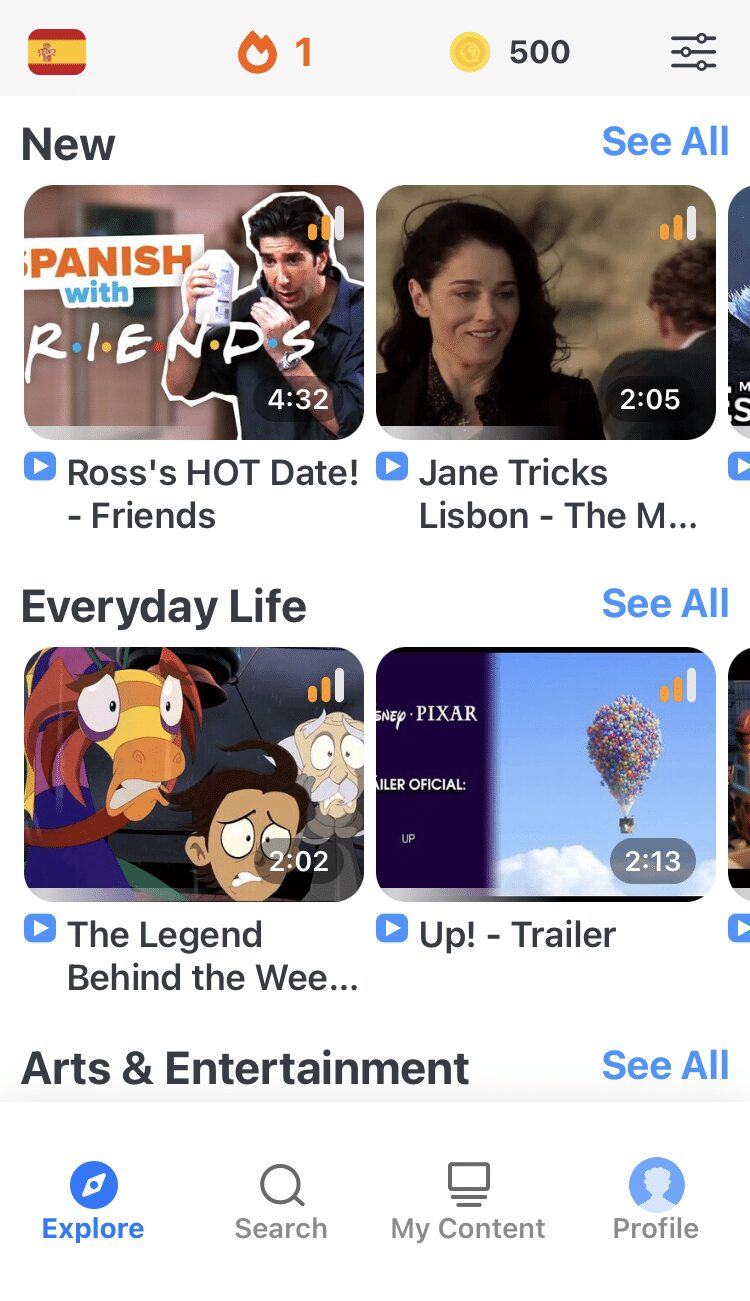Contents
- 1. Talk When You Read and Write
- 2. Watch Movies with Subtitles
- 3. Imitate Native Speakers
- 4. Think in Your Target Language
- 5. Listen to Local Music and Learn the Lyrics
- 6. Read Local Literature
- 7. Find a Language-learning Buddy
- 8. Talk to a Native Speaker
- 9. Visit a Place That Uses Your Target Language
- 10. Go Further with Dialects
- And One More Thing...
10 Tips to Speak Fluently in a Foreign Language

Many language learners tend to focus on the written form first. Don’t get me wrong: Reading and writing in your target language is important, however you also don’t want to neglect the spoken form.
If your goal is to be more confident when conversing with native speakers of your target language, you’ll want to take note of the 10 best learning tactics to help you speak another language fluently.
Download: This blog post is available as a convenient and portable PDF that you can take anywhere. Click here to get a copy. (Download)
1. Talk When You Read and Write
You may have noticed that most lessons in grammar books have a review and practice section. Instead of writing out your answers as usual, you can take another approach: read them out loud.
Don’t be afraid to get silly! Try to mimic the accent of a native speaker while doing this. Once you get into an actual conversation, your knowledge of grammar and vocabulary will shine through.
2. Watch Movies with Subtitles
Movie subtitles may seem boring and distracting, but they can come in handy for listening to and learning native speech.
To learn a spoken language through movie subtitles:
- Read the subtitles first. Take note of any words you don’t understand and look them up using your personal dictionary.
- Pronounce those words and try to get the accent right. If possible, use them in sentences where they make sense in context.
- Watch the movie again—without reading the subtitles this time. At this stage, you’ll want to understand as much of the speech as you can.
Luckily, there are online programs that make these steps much easier by pairing authentic content with learning tools. Since these videos are intended for native speakers, you can listen to the way people really talk.
FluentU takes authentic videos—like music videos, movie trailers, news and inspiring talks—and turns them into personalized language learning lessons.
You can try FluentU for free for 2 weeks. Check out the website or download the iOS app or Android app.
P.S. Click here to take advantage of our current sale! (Expires at the end of this month.)
3. Imitate Native Speakers
Going off the last tip, you can take the “Pronounce” step a bit further. (I suggest doing this independent of the “Read/Pronounce/Watch” method, but if you can do both at the same time and it works for you, no problem!)
This time, you should:
- Pause the film frequently and imitate the speech. Listen to the way the actors pronounce the words and try to do the same.
- Once you feel confident in your pronunciation, stop pausing. Try to parrot back what the characters are saying at the same time! This requires you to understand every word they say at each moment and spit it out quickly.
Of course, this is going to feel awkward at first. But the more you do it, the more the sounds and syllables of a foreign tongue will start to feel natural to you.
4. Think in Your Target Language
It can be difficult to learn to speak another language fluently if you’re always mentally translating it into your native tongue. That’s why you want to train yourself to think in your target language as much as possible.
Some question prompts you can use for this exercise are:
- What are you going to buy at the grocery store?
- How do you ask the bus driver to drop you off at a certain destination?
- How do you close a business deal?
If you’re having a hard time thinking in your target language, don’t worry! Jot down what you’re having trouble with and look up some of the most common conversational phrases you should know.
5. Listen to Local Music and Learn the Lyrics
If you listen closely to singers, you’ll notice how naturally their words flow. Songs are a great way to learn pronunciation and other aspects of language. Also, music is fun and helps you connect with the culture surrounding your target language.
Of course, you have to choose music with lyrics if you want to work on your fluency. Look up the lyrics online and try to sing along. Thanks to the Internet, you can find just about any song in any language—along with translations and romanized versions (if necessary).
6. Read Local Literature
Every country and culture has its masterful writers. Miguel de Cervantes wrote in Spanish, Italy has Dante Alighieri, Victor Hugo presented the sophistication of French expressions and the likes of Tolstoy and Dostoevsky revealed new dimensions of the Russian language.
It’s important to explore the literature written in the language you’re learning. For our purposes, though, you’ll want to circle back to Step 1 and read these books out loud.
Even better, get into poetry because it teaches you about rhythm. However, I only recommend this if you already have an advanced grasp of your target language. Poetry is chock-full of turns of phrases, idioms and double/hidden meanings that even native speakers struggle with!
7. Find a Language-learning Buddy
When you’re speaking out loud to yourself, it can be difficult to figure out what you’re doing wrong. You need feedback from a relatively objective third party to pinpoint exactly where you’re progressing and where you need to improve. That’s where a language-learning buddy comes in.
If you know someone who’s also learning your target language, you can hit them up. Ideally, they should be at a more advanced level than you, but what’s important is that you have a real human being to talk to and exchange feedback with. You can also make plans and set goals together, increasing your level of accountability and keeping you on track to fluency.
8. Talk to a Native Speaker
Having a language-learning buddy is great, but having a native speaker to talk to can take your language learning to another level.
The best part is you don’t have to travel far (or even outside your house!) to find a native speaker. You can also check out language exchange apps such as:

Once you’re in, you can either actively search for someone who meets your criteria and invite them out for coffee, or wait for someone to message you. Either way, you can help each other become fluent in the languages you’re learning, which include English, Spanish, French, Italian, German, Portuguese, Japanese, Mandarin Chinese, Korean, Arabic and Russian.

If you’re shy, you have the option to just chat with your language exchange partner; however, since you want to learn how to become fluent in a language in its spoken form, it’s better to take advantage of the voice messaging feature. Speaky is available to download from the App Store and Google Play so you can take your language exchange discussions anywhere.

The program is primarily designed to help you practice the language you’re learning. However, you may want to look elsewhere to learn the finer points, like grammar. If you want to read a more in-depth Tandem review (complete with pros and cons), look here.
Alternatively, you can download free language apps to your phone or take the best online language course that suits your level and budget.
9. Visit a Place That Uses Your Target Language
If you want to truly learn to speak another language, you have to understand the culture around it. You want to see and feel that culture from the inside out so that their idioms (among other things) will start to make sense.
Fortunately, most people are more than happy to help you brush up your language skills and teach you everything you need to know about navigating their geographical location and local customs.
Granted, traveling is an expensive endeavor. However, if you have the time and budget for it, the rewards can more than make up for the expensive plane tickets and accommodations.
10. Go Further with Dialects
Once you become fluent in the standardized form of the language you’re learning, you can move on to dialects. Dig deeper into how people speak depending on where they come from. Try to learn words specific to those areas and pronounce them the way native speakers do.
All of the above methods have one thing in common: They’re really fun.
Try them all, and see which ones work best for you! With the right strategy, it’s only a matter of time before you become Fluent you.
Download: This blog post is available as a convenient and portable PDF that you can take anywhere. Click here to get a copy. (Download)
And One More Thing...
If you dig the idea of learning on your own time from the comfort of your smart device with real-life authentic language content, you'll love using FluentU.
With FluentU, you'll learn real languages—as they're spoken by native speakers. FluentU has a wide variety of videos as you can see here:
With FluentU's Chrome extension, you can bring interactive learning tools directly to YouTube or Netflix, and even import your favorite YouTube videos directly into your FluentU account.
FluentU has interactive captions that let you tap on any word to see an image, definition, audio and useful examples. Now native language content is within reach with interactive transcripts.
Didn't catch something? Go back and listen again. Missed a word? Hover your mouse over the subtitles to instantly view definitions.
You can learn all the vocabulary in any video with FluentU's "learn mode." Swipe left or right to see more examples for the word you’re learning.
And FluentU always keeps track of vocabulary that you’re learning. It gives you extra practice with difficult words—and reminds you when it’s time to review what you’ve learned. You get a truly personalized experience.
Start using the FluentU website on your computer or tablet or, better yet, download the FluentU app from the iTunes or Google Play store. Click here to take advantage of our current sale! (Expires at the end of this month.)














